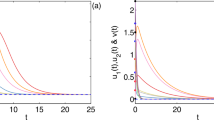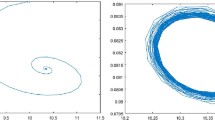Abstract
This paper studies a class of reaction-diffusion predator–prey system with stage-structured and anti-predation behavior. Based on the original deterministic system, we consider the prey refuge and study how it affects the stability of the populations. We first give the boundedness of solutions and then investigate the stability of equilibrium points with biological significance in the temporal system and spatial system. Further, the prey refuge is regarded as a bifurcation parameter for discussing the relevant Hopf bifurcation properties. Moreover, theoretical results show that the diffusion can cause Turing instability, interestingly, we find that a large diffusion rate of the prey can cause Turing instability, while large diffusion rates of predators would inhibit the appearance of Turing instability. Biologically, moderate anti-predation behavior among populations can promote system stability.














Similar content being viewed by others
Data availability
No data associated in the manuscript.
References
D.X. Geng, W.H. Jiang, Y. Lou, H.B. Wang, Spatiotemporal patterns in a diffusive predator–prey system with nonlocal intraspecific prey competition. Stud. Appl. Math. 148(1), 396–432 (2022)
S.Q. Zhang, S.L. Yuan, T.H. Zhang, A predator–prey model with different response functions to juvenile and adult prey in deterministic and stochastic environments. Appl. Math. Comput. 413(15), 126598 (2022)
C.H. Wang, S.L. Yuan, H. Wang, Spatiotemporal patterns of a diffusive prey–predator model with spatial memory and pregnancy period in an intimidatory environment. J. Math. Biol. 84(3), 12 (2022)
S. Kumar, R. Kumar, C. Cattani, B. Samet, Chaotic behaviour of fractional predator–prey dynamical system. Chaos Solitons Fract. 135, 109811 (2020)
A.J. Lotka, Analytical note on certain rhythmic relations in organic systems. Proc. Natl. Acad. Sci. 6, 410–415 (1920)
V. Volterra, Variazioni e fluttuazioni del numero individui in specie animali conviventi. Mem. Acad. Lincei Roma 2, 31–113 (1926)
Y.T. Cai, C.C. Wang, D.J. Fan, Bifurcation analysis of a predator–prey model with age structure. Int. J. Bifurc. Chaos 30(08), 2050114 (2020)
M.M. Chen, R. Yuan, Optimal harvesting for a predator-prey system with age structure and reserve area. Math. Methods Appl. Sci. 45, 11849–11874 (2022)
P. Yang, Hopf bifurcation of an age-structured prey–predator model with Holling type II functional response incorporating a prey refuge. Nonlinear Anal. Real. 49, 368–385 (2019)
B. Dubey, A. Kumar, Dynamics of prey–predator model with stage structure in prey including maturation and gestation delays. Nonlinear Dyn. 96, 2653–2679 (2019)
Y. Wang, X.F. Zou, On a predator–prey system with digestion delay and anti-predation strategy. J. Nonlinear Sci. 30, 1579–1605 (2020)
K.D. Prasad, B.S.R.V. Prasad, Qualitative analysis of additional food provided predator–prey system with anti-predator behaviour in prey. Nonlinear Dyn. 96, 1765–1793 (2019)
R.Z. Yang, J. Ma, Analysis of a diffusive predator-prey system with anti-predator behaviour and maturation delay. Chaos Solitons Fract. 109, 128–139 (2018)
F. Faraji, A. Janssen, M.W. Sabelis, Oviposition patterns in a predatory mite reduce the risk of egg predation caused by prey. Ecol. Entomol. 07, 660–664 (2002)
K. Able, S. Hagan, K. Kovitvongsa, S. Brown, J. Lamonaca, Piscivory by the mummichog (fundulus heteroclitus): evidence from the laboratory and saltmarshes. J. Exp. Mar. Biol. Ecol. 345, 26–37 (2007)
R. Kneib, Testing for indirect effects of predation in an intertidal soft-bottom community. Ecology 69, 1795–1805 (1998)
J. Li, X.H. Liu, C.J. Wei, The impact of role reversal on the dynamics of predator-prey model with stage structure. Appl. Math. Model 104, 339–357 (2022)
S. Aoki, U. Kurosu, S. Usuba, First instar larvae of the sugar-cane wooly aphid, Ceratovacuna lanigera (Homotera, Pemphigidae), attack its predators. Kontyu 52, 458–460 (1984)
W.D. Wang, L.S. Wang, A predator–prey system with stage-structure for predator. Comput. Math. Appl. 33, 83–91 (1997)
T.T. Ma, X.Z. Meng, T. Hayat, A. Hobiny, Hopf bifurcation induced by time delay and inflfluence of Allee effect in a diffusive predator–prey system with herd behavior and prey chemotaxis. Nonlinear Dyn. 108, 4581–4598 (2022)
J. Wang, Y.L. Cai, S.M. Fu, W.M. Wang, The effect of the fear factor on the dynamics of a predator–prey model incorporating the prey refuge. Chaos 29, 083109 (2019)
M. Das, G.P. Samanta, A delayed fractional order food chain model with fear effect and prey refuge. Math. Comput. Simul. 178, 237–267 (2020)
Y.L. Song, H.P. Jiang, Y. Yuan, Turing-Hopf bifurcation in the reaction-diffusion system with delay and application to a diffusive predator–prey model. J. Appl. Anal. Comput. 9, 1132–1164 (2019)
Y.L. Song, H.P. Jiang, Q.X. Liu, Y. Yuan, Spatiotemporal dynamics of the diffusive mussel-algae model near Turing-Hopf bifurcation. SIAM J. Appl. Dyn. Syst. 16(4), 2030–2062 (2017)
P. Mishra, S.N. Raw, B. Tiwari, On a cannibalistic predator–prey model with prey defense and diffusion. Appl. Math. Model. 90, 165–190 (2021)
B. Chakraborty, N. Bairagi, Complexity in a prey–predator model with prey refuge and diffusion. Ecol. Complex. 37, 11–23 (2019)
J. Murray, Mathematical biology: I. An introduction (Springer, 2002)
T.K. Kar, Stability analysis of a prey–predator model incorporating a prey refuge. Commun. Nonlinear Sci. 10, 681–691 (2005)
J.P. Shi, C.C. Wang, H. Wang, Spatial movement with diffusion and memory-based self-diffusion and cross-diffusion. J. Differ. Equ. 305, 242–269 (2021)
Y.L. Song, S.H. Wu, H. Wang, Spatiotemporal dynamics in the single population model with memory-based diffusion and nonlocal effect. J. Differ. Equ. 267, 6316–6351 (2019)
Y.L. Song, Y. Peng, T.H. Zhang, The spatially inhomogeneous Hopf bifurcation induced by memory delay in a memory-based diffusion system. J. Differ. Equ. 300, 597–624 (2021)
Acknowledgements
This work is supported by the National Natural Science Foundation of China (No. 12271308), the Shandong Provincial Natural Science Foundation (No. ZR2019MA003), the Research Fund for the Taishan Scholar Project of Shandong Province of China.
Author information
Authors and Affiliations
Corresponding author
Ethics declarations
Conflict of interest
The authors declare that they have no conflict of interest.
Rights and permissions
Springer Nature or its licensor (e.g. a society or other partner) holds exclusive rights to this article under a publishing agreement with the author(s) or other rightsholder(s); author self-archiving of the accepted manuscript version of this article is solely governed by the terms of such publishing agreement and applicable law.
About this article
Cite this article
Ma, T., Meng, X. & Alzahrani, A.K. Turing instability and Hopf bifurcation induced by prey refuge in a diffusive predator–prey system with stage structure and anti-predation. Eur. Phys. J. Plus 138, 624 (2023). https://doi.org/10.1140/epjp/s13360-023-04243-3
Received:
Accepted:
Published:
DOI: https://doi.org/10.1140/epjp/s13360-023-04243-3




